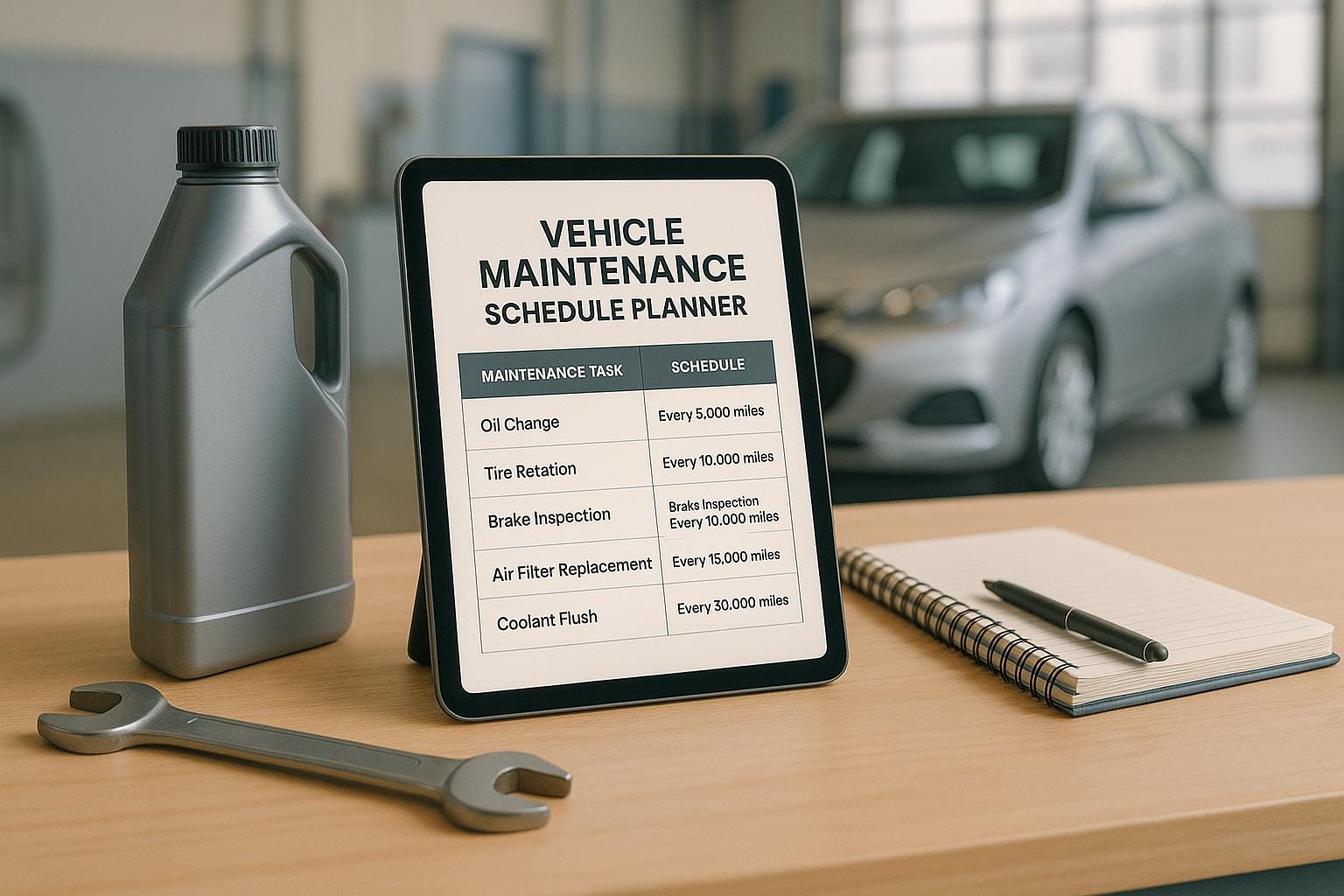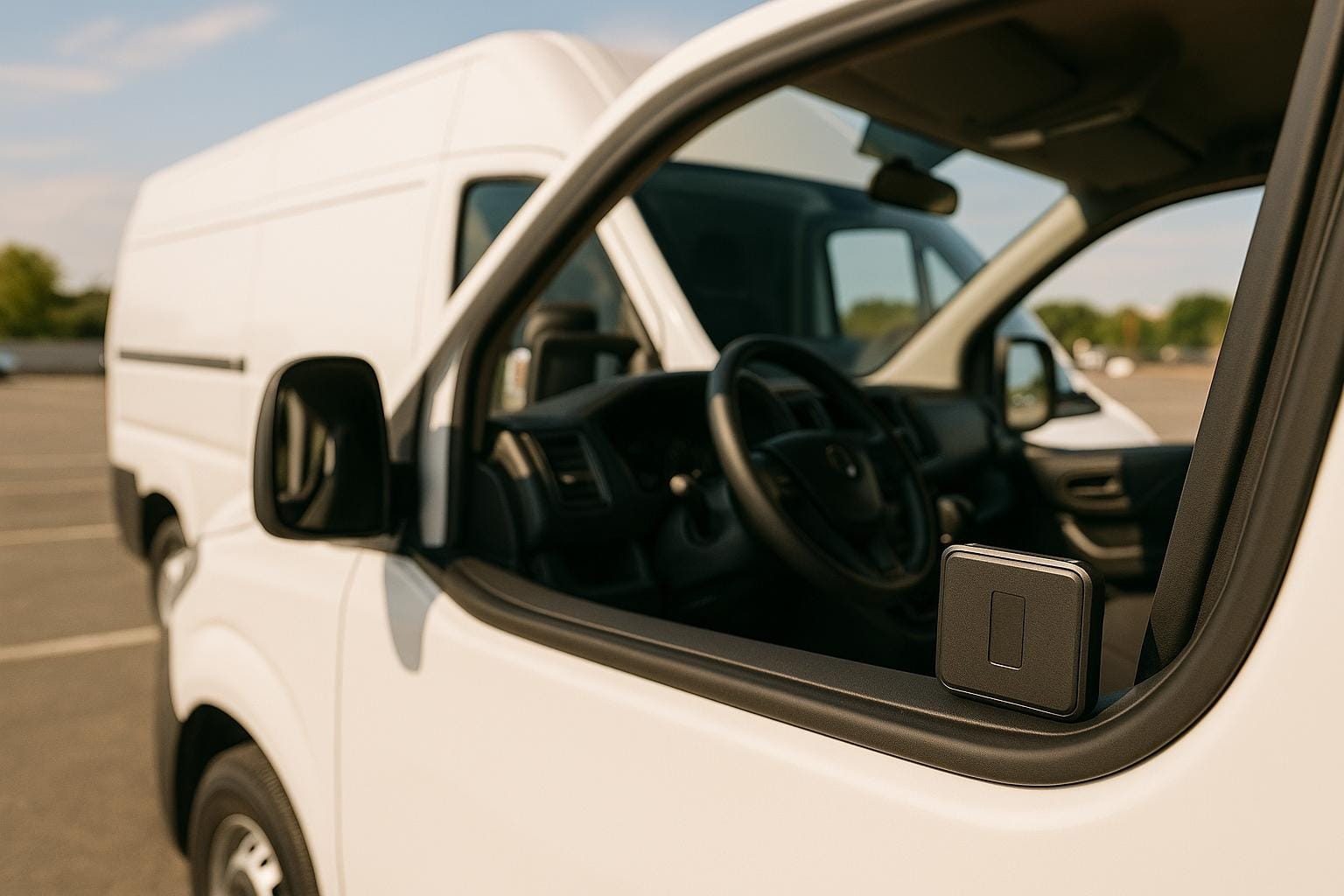Telematics can save fleets up to 20% on maintenance costs and 14–20% on fuel expenses. By monitoring vehicle health, driver behaviour, and operational data, telematics reduces unplanned downtime, extends vehicle lifespan, and improves efficiency. Here’s how it works:
- Real-time monitoring: Tracks engine performance, tyre pressure, and other diagnostics to detect issues early.
- Predictive maintenance: Uses data to schedule servicing only when needed, avoiding unnecessary repairs.
- Driver behaviour insights: Identifies habits like harsh braking or idling to reduce wear and tear.
- Cost tracking: Analyses expenses across vehicles to optimise budgets and improve Total Cost of Ownership (TCO).
For example, UK fleets using telematics reported a 30% drop in unplanned repairs and saved thousands annually through better maintenance and fuel management. With tools like automated alerts and route optimisation, telematics transforms fleet operations into a more efficient and cost-effective process.
How to lower fleet maintenance costs
Real-Time Vehicle Health Monitoring
Think of modern telematics as the digital nervous system of your fleet. It continuously gathers data from sensors and onboard diagnostic (OBD) systems, shifting maintenance strategies from reactive fixes to proactive prevention. This approach focuses on two crucial aspects: closely monitoring vehicle performance and spotting potential issues early.
"Vehicle telematics is the integration of telecommunications and monitoring systems within vehicles. It involves using GPS, onboard diagnostics, and a range of sensors to collect data on a vehicle's location, performance, and operational status." – Track Star
The collected data is sent to cloud platforms, where algorithms analyse it to identify emerging problems before they escalate.
Monitoring Key Performance Metrics
Telematics systems keep an eye on critical performance indicators that directly affect maintenance costs. For example, engine diagnostics monitor factors like temperature, oil pressure, and emissions levels in real time. Additionally, diagnostic trouble codes (DTC) alert fleet managers to developing mechanical issues, allowing repairs to be scheduled before they turn into costly breakdowns.
Driver behaviour also plays a significant role in vehicle health. Telematics tracks patterns like harsh acceleration, excessive idling, and aggressive braking - actions that can lead to premature wear and tear. By identifying these habits in real time, fleet managers can optimise driver performance. This not only extends the lifespan of vehicles but also improves overall operational efficiency.
Reducing Unplanned Downtime
Unplanned downtime can be a financial black hole for fleets. Northgate Vehicle Hire estimates that light commercial vehicle (LCV) fleets in the UK lose £2.4 billion annually due to idle vehicles, with each one costing around £800 per day. On top of that, 47% of fleets face fines or penalties when their vans are off the road for a week.
Telematics helps tackle this issue head-on. By tracking key metrics, it enables better maintenance scheduling and significantly reduces downtime. In fact, UK fleets using telematics for maintenance management saw a 30% drop in unplanned repairs in 2023, proving how effective the technology is at preventing costly breakdowns.
"The most expensive vehicle in your fleet is the one that's not moving." – Fleet Manager, UK Logistics Company
The key to avoiding breakdowns lies in early detection. Telematics systems provide graduated alerts as issues develop. For instance, a slight rise in engine temperature, unusual vibrations, or declining fuel efficiency can flag potential problems days - or even weeks - before a breakdown occurs.
This proactive approach has delivered impressive results. Transport for London (TfL) reported a 15% reduction in journey times across its fleet in 2023 by using telematics to optimise maintenance schedules. Similarly, a Manchester-based logistics firm saved £100,000 annually by leveraging telematics for route planning and fuel management. A London courier company also reported £75,000 in yearly savings thanks to improved operational efficiency. These examples highlight how telematics can drive significant cost savings for fleets.
Another advantage of telematics is its ability to send immediate alerts with diagnostic codes, enabling quick fixes and preventing small issues from escalating into major repairs. When integrated with fleet management software, the technology automates maintenance workflows, ensuring that no problem goes unaddressed.
For UK fleets looking to shift from reactive repairs to proactive maintenance, solutions like GRS Fleet Telematics (https://grsft.com) offer real-time monitoring and actionable insights, helping to reduce downtime and cut maintenance costs effectively.
Predictive and Scheduled Maintenance
Telematics has completely changed the game when it comes to vehicle maintenance. Instead of waiting for something to break, telematics uses data like historical patterns, mileage, engine hours, driving conditions, and component wear to predict potential failures. This shift allows fleets to move from traditional calendar-based servicing to a more precise, condition-based approach.
Automated Alerts and Service Scheduling
Modern telematics systems do more than just track service intervals - they actively monitor vehicle health and generate automated alerts for maintenance needs. These alerts cover everything from routine tasks like oil changes to more complex component replacements.
What makes this even more impressive is how these systems integrate with workshop scheduling software. For example, platforms like GRS Fleet Telematics combine real-time vehicle data with scheduling tools, automatically booking service appointments when alerts are triggered. This removes the hassle of manual coordination between fleet managers, drivers, and service providers, saving both time and effort.
Beyond convenience, automated alerts also help fleets stay compliant with UK regulations.
"By detecting risks as they happen and delivering immediate feedback – such as alerts or warnings – telematics actively prevents dangerous behaviours from escalating into incidents and that makes the roads safer for everyone."
– Philip van der Wilt, vice-president for Europe, the Middle East and Africa (EMEA) at Samsara
Fleet managers can customise alert thresholds to suit their operations. Whether it’s mileage-based servicing for vehicles with high usage or time-based maintenance for seasonal fleets, telematics ensures that maintenance schedules are tailored and efficient. This level of automation not only simplifies maintenance management but also plays a key role in extending the lifespan of vehicles.
Extending Vehicle Lifespan
Predictive maintenance isn’t just about avoiding breakdowns - it’s about keeping vehicles in top condition for as long as possible. By servicing or replacing components at the right time, telematics helps prevent the domino effect of one failure leading to another, ensuring vehicles stay on the road longer.
This approach also optimises fuel efficiency. A well-maintained engine, clean air filters, and properly inflated tyres all contribute to better fuel economy, reducing operational costs while extending the life of components. Condition-based servicing further eliminates unnecessary maintenance, ensuring parts are only replaced when truly needed, rather than prematurely.
"The key is turning the data into actionable insights. For example, identifying trends like frequent hard braking can indicate a need for driver training."
– Oliver Holt, Geotab EMEA sales manager
Telematics doesn’t just monitor the vehicles - it also tracks driver behaviour. Patterns like harsh braking, rapid acceleration, or excessive idling can cause unnecessary wear and tear. By identifying these habits, fleet managers can implement targeted driver training, which not only improves safety but also extends the life of vehicle components.
Combining predictive alerts with insights into driver behaviour creates a well-rounded maintenance strategy. It ensures vehicles last longer, reduces unexpected breakdowns, and helps fleets make the most of their maintenance budgets by focusing on actual needs instead of precautionary measures.
Tracking and Analysing Maintenance Costs
Building on proactive maintenance strategies, keeping a close eye on costs is key to improving fleet efficiency. Telematics systems have revolutionised how fleet managers monitor and analyse maintenance expenses. By tracking costs for each vehicle, component, and service type, these systems offer a clear breakdown of where money is being spent.
Telematics gathers data like diagnostic trouble codes (DTCs), odometer readings, and location history. This information forms the backbone of detailed cost analysis. With all this data centralised, expense tracking becomes more streamlined, making maintenance management far more efficient.
Using Analytics for Cost Reduction
Modern telematics platforms offer detailed reports that help fleet managers spot cost trends and make informed decisions. These reports can highlight patterns, such as vehicles that rack up higher repair costs due to tough driving conditions or poor driving habits.
Driver behaviour is a key area for cost savings. For instance, aggressive driving can increase fuel consumption by 15–30% on motorways and up to 40% in urban areas. Rapid acceleration and heavy braking can further reduce fuel efficiency by 33% during motorway driving. By monitoring these behaviours, fleet managers can introduce training programmes aimed at reducing fuel costs and minimising wear and tear on vehicles.
Here’s a real-world example: A bus operator used telematics to monitor engine temperature. When it exceeded 103°C, an alert was triggered, allowing timely intervention. This simple step saved three engines and nearly £32,000.
Telematics also helps with smarter parts procurement and service scheduling. Analysing maintenance history and operational data enables fleet managers to predict when specific components will need replacing. This ensures parts are available when needed, avoiding unnecessary delays.
Comparing Costs Before and After Telematics
The financial advantages of telematics become even clearer when comparing costs over time. For example, one company spent about 1.7 pence per mile on maintenance during a vehicle’s first year, which rose to roughly 13 pence per mile by the seventh year. This steep increase highlights how proactive maintenance through telematics can help control costs.
Fleet operators using telematics have reported impressive savings:
- Fuel costs: Reduced by 14–20%.
- Maintenance expenses: Lowered by 5–10% through predictive maintenance.
- Accident rates: Decreased by 20–30% thanks to better driver monitoring.
- Missed servicing: Nearly eliminated, as 18% of vehicles previously missed scheduled maintenance.
| Metric | Before Telematics | After Telematics | Improvement |
|---|---|---|---|
| Fuel Cost Reduction | Baseline | 14–20% savings | Up to 20% |
| Maintenance Cost Reduction | Reactive approach | Predictive approach | 5–10% savings |
| Accident Rates | Baseline | Monitored behaviour | 20–30% reduction |
| Missed Maintenance | 18% of vehicles | Automated scheduling | Near elimination |
Beyond these savings, the rising cost of maintenance adds urgency to smarter cost control. For instance, maintenance costs went up by 3.7% in Q4 2021 and by almost 10% compared to the previous year. For high-value vehicles like waste collection trucks, which can cost between £160,000 and £320,000 each, these savings are even more critical. By reducing downtime and extending vehicle lifespan, precise cost tracking through telematics ensures a stronger return on investment.
Improving Fleet Performance and Total Cost of Ownership
After delving into predictive maintenance, it's clear that understanding Total Cost of Ownership (TCO) highlights the strategic importance of telematics. By improving fleet performance and cutting costs across the board, telematics tackles the root causes of high maintenance expenses rather than just addressing the symptoms.
Telematics plays a big role in lowering TCO. Research shows that 47% of a fleet's TCO is influenced by driver behaviour. This statistic underscores how operational improvements driven by telematics can significantly impact financial outcomes, encouraging fleet managers to think beyond immediate maintenance costs. With maintenance savings and operational efficiencies in mind, let's explore how telematics enhances overall fleet performance and TCO.
Minimising Wear and Tear Through Smarter Operations
Efficient route planning is key to reducing vehicle wear and tear. Telematics systems use real-time data on traffic, weather, and vehicle health to enable dynamic route adjustments. This helps fleets avoid unnecessary mileage and harsh driving conditions.
"Fleet route optimization is more than mapping out the fastest route. It's about creating smarter, data-driven plans that consider everything - traffic, weather, proximity, and future trips." - Eric Schell, Telematics Products and Analytics Manager, Element
Optimised routing doesn’t just save time - it saves money too. Fuel costs drop by an average of 8%, with 55% of fleets reporting lower fuel expenses. This is crucial because fuel often represents the largest operational cost, with 32% of fleets identifying it as their biggest expense.
Driver behaviour also has a huge impact on TCO. By monitoring harsh acceleration, sudden braking, and speeding, telematics helps fleet managers pinpoint problem areas and provide targeted coaching. This not only reduces maintenance costs but also improves safety. For example, Day & Nite, a commercial refrigeration and HVAC services company, saw a 75% reduction in rear-end accidents within six months of introducing AI dash cameras. This led to lower insurance premiums and fewer accident-related expenses.
Evaluating Total Cost of Ownership
Operational improvements lay the foundation for a more precise evaluation of TCO. Telematics transforms TCO analysis into a data-driven process, offering insights across the entire vehicle lifecycle - from acquisition to disposal. This allows fleet managers to make smarter decisions at every step.
"The key to optimising TCO is to use data-driven insights to inform decisions."
Telematics supports TCO optimisation through a three-stage approach:
| Stage | Action | Benefit |
|---|---|---|
| Vehicle Selection & Financing | Analyse organisational needs and financing options | Better vehicle choices and financing strategies |
| Vehicle Operation | Manage maintenance, fuel, tyres, compliance, and driver behaviour | Lower operating costs and improved performance |
| Vehicle Disposal | Use data to determine the best time to sell vehicles | Maximised resale value and return on investment |
Telematics solutions can save fleets up to 14% on fuel costs. These savings add up over time, as reduced wear and tear extends vehicle lifespans and boosts resale values.
Telematics is also invaluable for evaluating new vehicle technologies. Fleet managers can use the data to compare tyre brands, test different vehicle models, or explore alternative fuel options. For fleets transitioning to electric vehicles, telematics monitors battery usage and charging patterns, helping managers develop effective deployment strategies.
By analysing historical data, fleet managers can spot trends in maintenance, fuel usage, and overall efficiency. This insight helps predict future costs and identify areas for further improvement. This proactive approach ensures that TCO optimisation becomes an ongoing effort, not just a one-time task.
"The return on telematics is quite immediate, maybe about a month. Fleet managers could see 15 to 20% savings on their costs. With this, they can invest in other things for their employees." - Juan Cardona, VP Sales, Latin America at Geotab
Conclusion
Telematics transforms fleet maintenance from a reactive chore into a proactive, data-focused strategy that helps businesses save money. By harnessing telematics, companies can significantly lower maintenance costs through real-time vehicle health updates, predictive maintenance alerts, and detailed expense tracking. This data-driven approach delivers measurable results.
Fleet managers can see fuel savings of 10–15% and cut maintenance expenses by up to 20% through smarter optimisation. When combined with benefits like reduced unplanned downtime and longer vehicle lifespans, these savings grow over time, offering a solid return on investment.
With real-time monitoring, key metrics such as engine performance, brake wear, and tyre pressure are tracked, allowing issues to be addressed before they become expensive problems. This predictive approach not only reduces costs but also keeps vehicles on the road longer, boosting overall productivity. Instead of just addressing symptoms, telematics tackles the root causes of high maintenance expenses, improving the total cost of ownership. These efficiencies enhance both operational performance and fleet reliability.
GRS Fleet Telematics builds on these benefits, offering systems designed to provide real-time data and actionable insights. For UK businesses, their solutions start at just £7.99 per month. Features like intelligent route planning, fuel efficiency tracking, and maintenance management help fleets achieve these cost savings. Their Enhanced and Ultimate packages also add security advantages, including a 91% vehicle recovery rate, safeguarding your assets while cutting maintenance costs.
FAQs
How can telematics help fleet managers reduce overall costs?
Telematics offers fleet managers a powerful tool to cut costs by delivering real-time insights into vehicle health and performance. With this information, managers can schedule preventative maintenance, helping to avoid unexpected breakdowns and expensive repairs. Catching issues early means vehicles stay on the road longer and experience less downtime.
It also plays a key role in improving fuel efficiency and optimising vehicle usage. By analysing driving behaviours and route data, telematics helps reduce fuel consumption and streamline operations. This makes it easier for fleet managers to make informed, data-driven decisions that lower expenses and enhance overall efficiency, ultimately reducing the Total Cost of Ownership (TCO).
What driver behaviours does telematics track to help lower maintenance costs, and how can fleet managers address them?
Telematics systems keep track of important driving habits like speeding, harsh acceleration, sudden braking, and sharp cornering. These behaviours not only increase the risk of accidents but also cause unnecessary wear and tear on vehicles, driving up maintenance expenses over time.
Fleet managers can address these challenges by implementing targeted driver training programmes, utilising telematics alerts to provide real-time feedback, and establishing clear safety guidelines. Tackling risky driving habits helps businesses extend the lifespan of their vehicles, cut down on repair costs, and boost overall fleet performance.
How does telematics-based predictive maintenance save costs compared to traditional maintenance methods?
Telematics-based predictive maintenance offers a smarter way for businesses to cut costs and keep their vehicles running smoothly. By spotting potential issues early, this method helps avoid unexpected breakdowns and extends the life of vehicle components. The result? Fewer unplanned repairs and more time spent on the road, boosting overall efficiency.
Unlike the traditional approach, which sticks to fixed schedules or reacts to problems after they occur, telematics relies on real-time data. It monitors vehicle health and usage patterns, enabling businesses to tackle issues before they worsen. This can lead to maintenance cost savings of up to 25% and a reduction in unexpected breakdowns by 70–75%. The added reliability and reduced downtime make it easier to manage budgets and optimise fleet operations.




